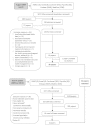The impact of mobile monitoring technologies on glycosylated hemoglobin in diabetes: a systematic review
- PMID: 23063046
- PMCID: PMC3570854
- DOI: 10.1177/193229681200600524
The impact of mobile monitoring technologies on glycosylated hemoglobin in diabetes: a systematic review
Abstract
Background: A new development in the field of telehealth is the use of mobile health technologies (mhealth) to help patients record and track medical information. Mhealth appears particularly advantageous for conditions that require intense and ongoing monitoring, such as diabetes, and where people are of working age and not disabled. This review aims to evaluate the evidence for the effectiveness of mhealth interventions in diabetes management on glycosylated hemoglobin.
Method: A comprehensive search strategy was developed and applied to eight electronic databases to identify studies that investigated the clinical effectiveness of mobile-based applications that allowed patients to record and send their blood glucose readings to a central server. The eligibility of 8543 papers was assessed against the selection criteria, and 24 papers were reviewed. All studies reviewed were assessed for quality using a standardized quality assessment tool.
Results: Results for patients with type 1 and type 2 diabetes were examined separately. Study variability and poor reporting made comparison difficult, and most studies had important methodological weaknesses. Evidence on the effectiveness of mhealth interventions for diabetes was inconsistent for both types of diabetes and remains weak.
© 2012 Diabetes Technology Society.
Figures
References
-
- Davidson MB. Counterpoint: self-monitoring of blood glucose in type 2 diabetic patients not receiving insulin: a waste of money. Diabetes Care. 2005;28(6):1531–1533. - PubMed
-
- Clar C, Barnard K, Cummins E, Royle P, Waugh N. Aberdeen Health Technology Assessment Group. Self-monitoring of blood glucose in type 2 diabetes: systematic review. Health Technol Assess. 2010;14(12):1–140. - PubMed
-
- Montori VM, Helgemoe PK, Guyatt GH, Dean DS, Leung TW, Smith SA, Kudva YC. Telecare for patients with type 1 diabetes and inadequate glycemic control: a randomized controlled trial and meta-analysis. Diabetes Care. 2004;27(5):1088–1094. - PubMed
-
- Farmer A, Gibson OJ, Tarassenko L, Neil A. A systematic review of telemedicine interventions to support blood glucose self-monitoring in diabetes. Diabet Med. 2005;22(10):1372–1378. - PubMed
Publication types
MeSH terms
Substances
Grants and funding
LinkOut - more resources
Full Text Sources
Medical


